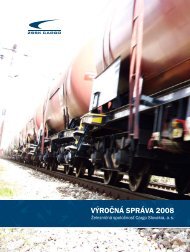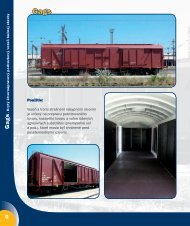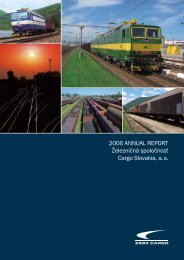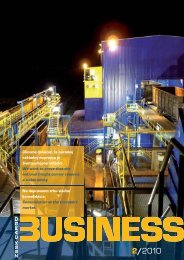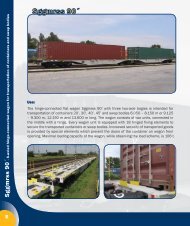CARGO BUSINESS 1-10.indd - ZSSK Cargo
CARGO BUSINESS 1-10.indd - ZSSK Cargo
CARGO BUSINESS 1-10.indd - ZSSK Cargo
- No tags were found...
You also want an ePaper? Increase the reach of your titles
YUMPU automatically turns print PDFs into web optimized ePapers that Google loves.
Before the transportation is ordered, it is necessary to consider which<br />
type of freight wagon to choose with regard to the type and nature<br />
of the goods. In practice, it means to choose a wagon with sufficient<br />
loading surface, not forgetting the area intented for goods securing,<br />
the area providing free space, or protective distance. These are<br />
necessary issues to be taken into account, related to physical impacts<br />
during transportation and to selected way of goods placement.<br />
Goods stressing during transportation<br />
During any transportation, the goods are exposed to certain<br />
forces and stress. In rail traffic, these are mainly forces in<br />
lengthways direction of the wagon. These forces are generated<br />
during train formation as well as during their sudden acceleration<br />
and deceleration. They can reach several times the weight of the<br />
consignment. In this case, it should be mentioned that in case of<br />
freight wagons, arranged into block trains and in combined transport,<br />
these forces are smaller.<br />
We must also not forget the forces in transverse direction of the<br />
wagon, arising in particular when driving in curves and over the<br />
roadway supports. These forces can reach up to 0.5 times the weight<br />
of the consignment. Other forces to be taken into account are the<br />
forces vertically upwards. They reduce friction between the goods<br />
and the wagon floor by one third. To sum it up, during transportation<br />
under normal operating conditions, the following values of stress are<br />
achieved:<br />
- In the lengthways direction up to four times the weight of cargo (4 G)<br />
- In the transverse direction up to 0.5 times the weight of cargo (0.5 G)<br />
- In the vertical direction up to 0.3 times the weight of cargo (0.3 G).<br />
Goods packaging<br />
In addition to the impact of these forces, the resonant phenomena<br />
in frequency range of over 50 Hz arise during transportation by rail.<br />
These impacts may cause damage to certain particularly sensitive<br />
machines and devices. How can this type of stress be withstood In<br />
this case, the method of goods securing does not play a major role.<br />
Packaging is important. All those who produce sensitive goods, must<br />
take into account this type of stress when planning the packaging.<br />
Freight wagon on the ship<br />
Other principles apply to the consignments to be transported on<br />
freight wagons on the ship. In this case it is necessary to take<br />
into account greater stresses than those set for rail traffic before<br />
loading the wagon. They are significantly different for individual ship<br />
transportations. In general, sea transport is based on the following<br />
forces:<br />
- In the longitudinal direction 0.2 times the weight of cargo (0.2 G)<br />
- In the transverse direction 0.7 times the weight of cargo (0.7 G)<br />
- In the vertical direction 2.2 times the weight of cargo (2.2 G)<br />
Loading and load securing<br />
Measures taken to protect the goods against damage must reflect the<br />
specific stress of the relevant means of transport. When loading and<br />
securing the goods, it is necessary to be aware of the fact that the<br />
cargo and securing equipment must withstand the effects of inertia<br />
forces generated by the impacts and shocks during transportation.<br />
We may state that the decisive influence to preserve the integrity of<br />
loaded goods, freight wagon as well as to maintain the operational<br />
safety during transport is the method of loading and load securing.<br />
Possibilities of loading and load securing enable to use a sliding<br />
method of loading or a rigid method of loading.<br />
Rigid method of goods loading<br />
Rigid (or compact or fixed) method of loading exposes the goods<br />
and securing equipment in full extent to forces applied during the<br />
transportation of goods in the lengthways, transverse and vertical<br />
direction. This method is based on the following:<br />
- Individual pieces or groups of cargo parts are secured in a fixed<br />
way, i.e. without the possibility of movement in the transverse or<br />
lengthways direction of the wagon. Special securing equipment can be<br />
used for these purposes.<br />
- Goods of equal parts (components, such as goods in cardboard<br />
containers, on pallets...) are loaded from the front wall to the front<br />
wall of the wagon without any gaps, or the remaining gaps filled with<br />
resilient material.<br />
What can be used to fill the gaps mentioned above It depends on<br />
their size, i.e. for smaller gaps the wooden skids, inflatable bags,<br />
placed pallets can be used ... For larger gaps, skids of prisms can<br />
be used. When using this method of loading it is essential to realize<br />
that part of the cargo at front wall of wagons is exposed to pressure<br />
of the entire load. If these parts of the cargo do not have sufficient<br />
resistance, the load must be divided into groups. Each group will be<br />
secured individually. Let us mention the basic principles that must be<br />
followed in case of rigid loading:<br />
a) Distribution and stacking of goods<br />
Special attention must be paid to goods evenly distributed on the<br />
entire loading surface. If the upper layer cannot be completely filled<br />
when stacking, the goods in this part must be arranged into groups<br />
and secured together. Stack height must not be greater than its width.<br />
Heavy goods shall be placed into lower layers and light goods shall be<br />
placed into upper layers. When creating a stack of goods of different<br />
lengths and weights, it is necessary to make sure that long and heavy<br />
parts of cargo are stored at the bottom. Unevenly thick and heavy ends<br />
of the goods must be alternated. Fragile goods or goods of different<br />
shapes cannot be loaded in lengthways direction of the wagon directly<br />
one by one. Such goods must be placed in between other goods.<br />
b) Bounding or grouping of goods<br />
The requirement to group or bound the goods is related to those goods<br />
which tend to move or accumulate during transportation, e.g. tubes or<br />
thin boards. Suitable aids are partitions, shrink wrapping, etc...<br />
c) Loading of sensitive, long or flat goods<br />
Such goods are loaded in lengthways direction of the wagon. Flat<br />
pieces are loaded upright on the narrower side. In particular, it<br />
concerns the loading of ceramic tubes, cement tiles and so forth.<br />
d) Loading of goods in the area of walls, doors and stanchions<br />
In this case it is necessary to be aware of the fact that cargo, touching<br />
the walls and sidewalls of the wagon, cannot damage these parts.<br />
Sliding doors, sliding walls, covers and roofs that can be opened must<br />
not be blocked by cargo. They must open and close safely.<br />
Kristína JÁNOŠOVÁ<br />
Operations and Transportation Section<br />
28/29








